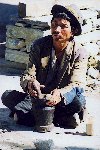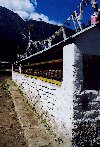When
 people walk, they also take the time to stop and chat. Often about where they are
going and the road ahead, checking directions and the time to the next village.
There are families spread out along the valley for miles and the pathside conversation
is what keeps family members in touch. Household chores are often carried out in public also.
The man on the left is grinding roasted cumin. You will also see people weaving bamboo,
repairing clothes, threshing wheat.
People wash on the side of the street. A cluster of toothbrushes pokes out from around the
public water pipe and there are usually a few bars of soap there too.
people walk, they also take the time to stop and chat. Often about where they are
going and the road ahead, checking directions and the time to the next village.
There are families spread out along the valley for miles and the pathside conversation
is what keeps family members in touch. Household chores are often carried out in public also.
The man on the left is grinding roasted cumin. You will also see people weaving bamboo,
repairing clothes, threshing wheat.
People wash on the side of the street. A cluster of toothbrushes pokes out from around the
public water pipe and there are usually a few bars of soap there too.
Animals
 are casually slaughtered on the side of the path.
Typically the unfortunate animal is lead to the middle of the road, some food stuff is thrown
down to distract it and it is beheaded on the spot. The butchers then scorch the carcass with burning
kerosene to remove any hair and skin it. If it is a buffalo which is being slaughtered, the pelt is
layed out on the ground and each customers neat parcel of meat is layed out on it for collection.
The whole operation is over within a half hour, leaving nothing but a stain on the road after it has finished.
are casually slaughtered on the side of the path.
Typically the unfortunate animal is lead to the middle of the road, some food stuff is thrown
down to distract it and it is beheaded on the spot. The butchers then scorch the carcass with burning
kerosene to remove any hair and skin it. If it is a buffalo which is being slaughtered, the pelt is
layed out on the ground and each customers neat parcel of meat is layed out on it for collection.
The whole operation is over within a half hour, leaving nothing but a stain on the road after it has finished.
Religion
 too plays a strong part in the life of the valley. Hinduism and Buddhism are the
two major evident philosophies, but there are intermingled effects of local chamanism and animism
which vary from region to region. All the major Hindu festivals are celebrated in Nepal and Buddhist
prayer flags and chortens are evident in many places along the road. There is a strong Tibetan
influence on the buddhism in this region. Before the Chinese invasion, there was much trading
across the Tibetan border to the north east. Since 1959, many Tibetans
have fled to Nepal and settled in the Marsyangdi valley and other areas.
too plays a strong part in the life of the valley. Hinduism and Buddhism are the
two major evident philosophies, but there are intermingled effects of local chamanism and animism
which vary from region to region. All the major Hindu festivals are celebrated in Nepal and Buddhist
prayer flags and chortens are evident in many places along the road. There is a strong Tibetan
influence on the buddhism in this region. Before the Chinese invasion, there was much trading
across the Tibetan border to the north east. Since 1959, many Tibetans
have fled to Nepal and settled in the Marsyangdi valley and other areas.

